What are macarons?
Macarons are all the rage now, and you’re sure to find them from Beijing to Rio. But, in case you haven’t come across them yet, here’s a nice picture:
A perfect macaron has two almond-meringue pastries that have been cooked to be smooth and crisp, and the middle is filled with a cream, jam, or some other tasty ingredient (sometimes even something unexpected, like foie gras!)
Where do they come from?
The origins of “macarons”, a small French delicacy, are very mysterious and controversial. Some people say that the first recipes come from Italy, and that Catherine di Medici brought them with her when she travelled to France, during the renaissance period. Old-style macarons didn’t have any filling; they where just a cooked confection made of ground almonds, egg whites and sugar. Only at the beginning of the 20th century did Pierre Desfontaines, the grandson of Louis Ernest Ladurée (who founded the famous salon de thé in Paris) have the idea to fill them with a “chocolate panache” and to stick them together by pairs.
So, I would like to share with you the way I prepare the delicious French macaron. After three failed tests, I thought that I would never get them right, but luckily I’ve learned that it only takes a bit of persistence (and knowing your oven) to get some beautiful results. In a moment of madness, my husband (boyfriend at the time) and I even prepared 300 macarons for our wedding guests.
The basic texture of a macaron depends on the mix of an almond paste with a meringue, which will give it crunchiness and a soft interior once cooked. There are two main ways to prepare a macaron, depending on the kind of meringue used: Italian or French. French meringue is easier to prepare, and used for many other dishes. You just mix beaten egg-whites with raw powder sugar. Fast, and less tricky, but the result is not so smooth. Italian meringue (which funnily enough is more popular in France) uses cooked sugar, and is more resistant and smooth.
What equipment do you need ?
A good, reliable oven (it can be even a small electrical one – it works perfectly with mine), an oven tray or a silicone baking mat, a plastic spatula, an electrical whisk (or Kitchen-aid style mixer) and a nozzled piping bag.
Recipe for Italian meringue macarons
Yield: 40 macarons, size 3 cm diameter
Ingredients
- 200g almond powder (for my pistache macarons I added 30-40% of pistache powder, for the chocolate ones, I added 20g cacao powder)
- 200g icing sugar
- 160g egg whites (2 x 80g)
- 200gr caster sugar
- 5cl water
Step by step
- Three to two days before baking: separate the egg whites from the yolks, take 160gr egg whites and put them into a container and cover it. This will make sure that your egg whites are clear and liquid when you use them.
- One day before baking: take out the egg whites from the fridge – you need them to be at room temperature.
- When you’re ready to get started: mix the same amount of almond powder and icing sugar (what the French call “tant pour tant”). Then sift the mixture twice to make sure that it is smooth.
- Pour 80g of egg whites into the almond powder/ sugar mixture and fold them gently into it, until it becomes a paste.
- Put the casting sugar and the water in a saucepan, put it on the fire and start cooking. Keep a thermometer handy to check the temperature. If sugar seems to run up the edges of the saucepan, you can use a soft brush dipped into water to clean the edges and recover the sugar.
- While the sugar is cooking, pour the remaining 80g of egg whites into a bowl and whisk it at medium speed into a soft peak (already consistent, but not too hard). Do not make them into a hard meringue yet. If you have a robot, you can start whisking once the sugar is at 115ºC.
- Once the sugar reaches 120ºC, take it off the fire, wait briefly until it isn’t bubbling (30s or so) and pour it slowly onto the whites while you keep whisking them.
- Keep whisking the whites until they cool down (you can touch the bottom of the bowl to check). If you want to add a color to your macarons, you can put a bit of powder colorant into the whites. You can also use liquid colorants, but those are used with the “tant-pour-tant” mixture.
- Once the Italian meringue (beaten egg whites + melted sugar) has cooled down, you should be able to take your whisk out and have a long “bird beak” form, without dripping.
- Now comes the most delicate part: take part of the meringue and fold it slowly into the tant-pour-tant + egg-white paste. Keep adding egg-white in three times and fold it together with a movement that is called “macaronner”: with a spatula, fold the mixture from the sides onto the middle, and then plunge the spatula down and to the side to start again. The mixture should become smooth, elastic and shiny. Once the mixture flows down from the spatula continuously, folding like on sheets, it is ready.
- Fill the piping bag with the mixture and pour small circles, about 2.5cm in diameter, onto your baking tray (covered with baking paper) or silicone baking-mat. You should keep the bag and nooze still while piping, and do a quick motion upwards to finish each circle. Leave at least 1-1.5cm free space around each circle, so that they don’t become a big blob when they cook. By now you should start pre-heating your oven at 140ºC.
- You can lift the tray a few centimeters above your baking surface and let it fall to get rid of any “spikes” and get a smooth round surface. Let the macarons dry for around half an hour before putting them into the oven; the surface should not be sticky when you touch them.
- Cook the macarons for 12 minutes at 140ºC. You should open-and-close the oven shortly to let the water vapor come out after 2 minutes of baking and again at the 10th minute.
- If everything went right, the macarons should have risen, and there should be a “collerette” around the base (a thin ring of different-textured paste). Take the tray out of the oven, put either the baking mat or the baking paper with the macarons on a cool surface, and then lift the macarons carefully to separate them from the paper. You can use a spatula to help this along if necessary. Now you have nice macaron shells, ready to be filled!
The filling
There are many choices for the filling, from caramel to foie-gras. The key is that it should be a soft, mousse-like substance. If you want to be even more original, you can put also a bit of a different, more consistent ingredient (a fruit piece, harder caramel, chocolate) in the middle.
For the macarons in this example, I prepared a simple chocolate filling, with the following ingredients:
- 200g black chocolat
- 200cl liquid cream
Warm up the cream in a pot, mix in the chocolate in small pieces, and stir until it is smooth and shiny. Let it cool down before you put it in a piping bag, which you can use to fill the macarons.
Pour the filling in a spiral from the center, and be generous with it! Match another shell of approximately the same size and put both together as if making a hamburger :). You can turn slightly both shells while pressing them together to even out the amount of filling inside.
Your macarons are ready! But it’s not yet the best moment to eat them. They’ll be best one to two days after being made, and can last for up to a week, depending on the filling. You should store them in a closed container in the fridge. I usually make a bunch at a time, and freeze a large part of it for up to a couple of months. You just take them out and put them into the freezer two days before eating them.
Enjoy!
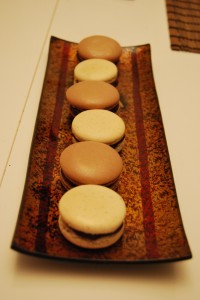
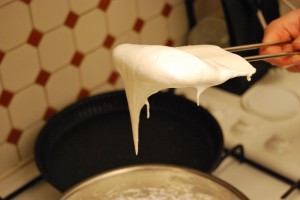
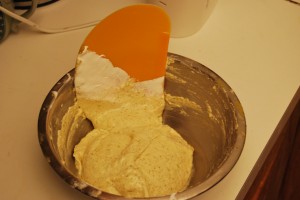
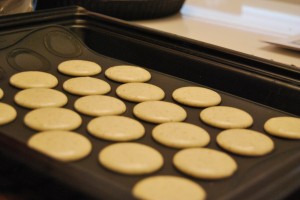
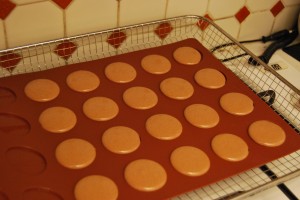
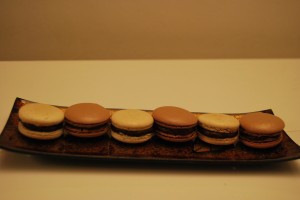
¡¡Que bueno todo!! Gracias Ilze por ofrecernos unas recetas tan ricas y fáciles de hacer. Me han encantado. Enhorabuena por tu blog.